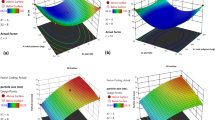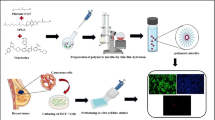Abstract
Purpose
In this study, tocopherol based polymeric micelles were successfully prepared to enhance the anticancer effect of fisetin (FIS) in breast cancer cells.
Methods
The drug-loaded carrier was characterized in terms of physicochemical and in vivo parameters.
Results
Compared to FIS, FIS-TPN showed higher cellular uptake in MCF-7 breast cancer cells as revealed by CLSM and flow cytometry. The cytotoxicity assay results clearly showed that the free FIS and FIS-TPN exhibited a typical dose-dependent toxic effect in MCF-7 breast cancer cells. Especially, enhanced cytotoxic effect of FIS was observed when loaded in a nanocarrier. Free FIS induced a ~11% apoptosis whereas FIS-TPN induced a significantly greater apoptosis of ~20% by the end of 24 h. At 48 h, similar trend continued and free FIS showed ~30% of apoptosis whereas ~42% cell apoptosis was observed in FIS-TPN treated group. Notably, migration of cancer cell was significantly inhibited when treated with FIS-TPN formulations. The FIS-TPN significantly reduced to tumor burden and H&E staining showed the lowest tumor volume and higher cell apoptosis.
Conclusions
All the findings suggest that the fisetin-loaded TPGS-PLA polymeric micelles serve as a potential candidate and promising alternative for the effective treatment of breast cancers.







Similar content being viewed by others
Abbreviations
- DLS:
-
Dynamic might scattering
- EPR:
-
Enhanced permeation and retention effect
- FIS:
-
Fisetin
- FIS-TPN:
-
Fisetin-loaded TPGS/PLA nanoparticles
- NP:
-
Nanoparticles
- PLA:
-
Poly(lactide)
- TPGS:
-
D-α-tocopheryl polyethylene glycol 1000
References
Siegel R, Ward E, Brawley O, Jemal A. Cancer statistics, 2011: the impact of eliminating socioeconomic and racial disparities on premature cancer deaths. CA Cancer J Clin. 2011;61:212–36.
Kamangar F, Dores GM, Anderson WF. Patterns of cancer incidence, mortality, and prevalence across five continents: defining priorities to reduce cancer disparities in different geographic regions of the world. J Clin Oncol. 2006;24:2137–50.
Coley HM. Mechanisms and strategies to overcome chemotherapy resistancein metastatic breast cancer. Cancer Treat Rev. 2008;34:378–90.
Carey L, Winer E, Viale G, Cameron D, Gianni L. Triple-negative breast cancer: disease entity or title of convenience? Nat Rev Clin Oncol. 2010;7:683–92.
Carey LA. Triple-negative (basal-like) breast cancer: a new entity. Breast Cancer Res. 2007;9 Suppl 1:S1.
Arai Y, Watanabe S, Kimira M, Shimoi S, Mochizuki R, Kinae N. Dietaryintakes of flavonols, flavones and isoflavones by Japanese women and theinverse correlation between quercetin intake and plasma LDL cholesterolconcentration. J Nutr. 2000;130:2243–50.
Kimira M, Arai Y, Shimoi K, Watanabe S. Japanese intake of flavonoids andisoflavonoids from foods. J Epidemiol. 1998;8:168–75.
Woodman OL, Chan EC. Vascular and anti-oxidant actions of flavonols andflavones. Clin Exp Pharmacol Physiol. 2004;31:786–90.
Park HH, Lee S, Oh JM, Lee MS, Yoon KH, Park BH, et al. Anti-inflammatory activity of fisetin in human mast cells (HMC-1). Pharmacol Res. 2007;55:31–7.
Jang KY, Jeong SJ, Kim SH, Jung JH, Kim JH, Koh W, et al. Activation of reactive oxygen species/AMP activated protein kinase signaling mediates fisetin-induced apoptosis in multiple myeloma U266 cells. Cancer Lett. 2012;319:197–202.
Suh Y, Afaq F, Johnson JJ, Mukhtar A. A plant flavonoid fisetin inducesapoptosis in colon cancer cells by inhibition of COX2 and Wnt/EGFR/NF-kappaB-signaling pathways. Carcinogenesis. 2009;30:300–7.
Syed DN, Afaq F, Maddodi N, Johnson JJ, Sarfaraz S, Ahmad A, et al. Inhibition of human melanoma cell growth by the dietary flavonoid fisetin is associated with disruption of Wnt/beta-catenin signaling and decreased Mitf levels. J Invest Dermatol. 2011;131:1291–9.
Yang PM, Tseng HH, Peng CW, Chen WS, Chiu SJ. Dietary flavonoid fisetin targets caspase-3-deficient human breast cancer MCF-7 cells by induction of caspase-7 associated apoptosis and inhibition of autophagy. Int J Oncol. 2012;40:469–78.
Ying TH, Yang SF, Tsai SJ, Hsieh SC, Huang YC, Bau DT, et al. Fisetin induces apoptosis in human cervical cancer HeLa cells through ERK1/2- mediated activation of caspase-8-/caspase-3-dependent pathway. Arch Toxicol. 2012;86:263–73.
Guzzo MR, Uemi M, Donate PM, Nikolaou S, Machado AE, Okano LT. Study of the complexation of fisetin with cyclodextrins. J Phys Chem A. 2006;110:10545–51.
Rong X, Xie Y, Hao X, Chen T, Wang Y, Liu Y. Applications of polymeric nanocapsules in field of drug delivery systems. Curr Drug Discov Technol. 2011;8:173–87.
Craparo EF, Bondi ML. Application of polymeric nanoparticles in immunotherapy. Curr Opin Allergy Clin Immunol. 2012;12:658–64.
Kamaly N, Xiao Z, Valencia PM, Radovic-Moreno AF, Farokhzad OC. Targeted polymeric therapeutic nanoparticles: design, development and clinical translation. Chem Soc Rev. 2012;41:2971–3010.
Ramasamy T, Haidar ZS, et al. Layer-by-layer assembly of liposomal nanoparticles with PEGylated polyelectrolytes enhances systemic delivery of multiple anticancer drugs. Acta Biomater. 2014;10:5116–27.
de Melo-Diogo D, Gaspar VM, Costa EC, Moreira AF, Oppolzer D, Gallardo E, et al. Combinatorial delivery of Crizotinib-Palbociclib-Sildenafil using TPGS-PLA micelles for improved cancer treatment. Eur J Pharm Biopharm. 2014;88:718–29.
Zhang Z, Feng SS. Biomaterials. 2006;27:4025–33.
Kanai K, Kikuchi E, Mikami S, Suzuki E, Uchida Y, Kodaira K, et al. Vitamin E succinate induced apoptosis andenhanced chemosensitivity to paclitaxel in human bladder cancer cellsin vitro and in vivo. Cancer Sci. 2010;101:216–23.
Tran TH, Ramasamy T, Choi JY, et al. Tumor-targeting, pH-sensitive nanoparticles for docetaxel delivery to drug-resistant cancer cells. Int J Nanomed. 2015;10:5249.
Ramasamy T et al. Engineering of a lipid-polymer nanoarchitectural platform for highly effective combination therapy of doxorubicin and irinotecan. Chem Comm. 2015;51:5758–61.
Tang N, Du G, Wang N, Liu C, Hang H, Liang W. Improving penetration in tumors with nanoassemblies of phospholipids and doxorubicin. JNCI J Natl Cancer Inst. 2007;99:1004–15.
Prajakta D, Ratnesh J, Chandan K, Suresh S, Grace S, Meera V, et al. Curcumin loaded pH-sensitive nanoparticles for the treatment of colon cancer. J Biomed Nanotechnol. 2009;5:445–55.
ACKNOWLEDGMENTS AND DISCLOSURES
The study was supported from the Research Grant of Xinxiang Medical University, PR. China.
Author information
Authors and Affiliations
Corresponding author
Rights and permissions
About this article
Cite this article
Wang, L., Zhang, DZ. & Wang, YX. Bioflavonoid Fisetin Loaded α-Tocopherol-Poly(lactic acid)-Based Polymeric Micelles for Enhanced Anticancer Efficacy in Breast Cancers. Pharm Res 34, 453–461 (2017). https://doi.org/10.1007/s11095-016-2077-z
Received:
Accepted:
Published:
Issue Date:
DOI: https://doi.org/10.1007/s11095-016-2077-z




